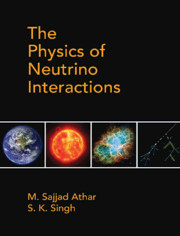Book contents
- Frontmatter
- Dedication
- Contents
- List of Figures
- List of Tables
- Preface
- Acknowledgments
- Chapter 1 Neutrino Properties and Its Interactions
- Chapter 2 Relativistic Particles and Neutrinos
- Chapter 3 Quantization of Free Particle Fields
- Chapter 4 Interacting Fields and Relativistic Perturbation Theory
- Chapter 5 Phenomenological Theory I: Nuclear β-decays and Weak Interaction of Leptons
- Chapter 6 Phenomenological Theory II: Weak Decays of Hadrons
- Chapter 7 Gauge Field Theories and Fundamental Interactions
- Chapter 8 Unified Theory of Electroweak Interactions
- Chapter 9 Neutrino and Electron Scattering from Point Particles
- Chapter 10 Neutrino scattering Cross Sections from Hadrons: Quasielastic Scattering
- Chapter 11 Neutrino Scattering from Hadrons: Inelastic Scattering (I)
- Chapter 12 Neutrino Scattering from Hadrons: Inelastic Scattering (II)
- Chapter 13 Neutrino Scattering from Hadrons: Deep Inelastic Scattering
- Chapter 14 Weak Quasielastic v(⊽)-nucleus Scattering
- Chapter 15 Inelastic Scattering of (Anti)neutrinos from Nuclei
- Chapter 16 Deep Inelastic Scattering of (Anti)neutrinos from Nuclei
- Chapter 17 Neutrino Sources and Detection of Neutrinos
- Chapter 18 Neutrino Mixing and Oscillations
- Chapter 19 Neutrino Astrophysics and the Synthesis of Elements
- Chapter 20 Neutrino Interactions Beyond the Standard Model
- Appendices
- Appendix A Lorentz Transformation and Covariance of the Dirac Equation
- Appendix B Cabibbo Theory
- Appendix C Some Properties of Pauli and Dirac Matrices and Spin Density Matrices
- Appendix D Leptonic and Hadronic Tensors
- Appendix E General Expression for the Total Scattering Cross Section and Decay Rates
- Appendix F Expressions of N(q2), the Coefficients of the Polarization Observables
- References
- Index
Chapter 1 - Neutrino Properties and Its Interactions
Published online by Cambridge University Press: 22 May 2020
- Frontmatter
- Dedication
- Contents
- List of Figures
- List of Tables
- Preface
- Acknowledgments
- Chapter 1 Neutrino Properties and Its Interactions
- Chapter 2 Relativistic Particles and Neutrinos
- Chapter 3 Quantization of Free Particle Fields
- Chapter 4 Interacting Fields and Relativistic Perturbation Theory
- Chapter 5 Phenomenological Theory I: Nuclear β-decays and Weak Interaction of Leptons
- Chapter 6 Phenomenological Theory II: Weak Decays of Hadrons
- Chapter 7 Gauge Field Theories and Fundamental Interactions
- Chapter 8 Unified Theory of Electroweak Interactions
- Chapter 9 Neutrino and Electron Scattering from Point Particles
- Chapter 10 Neutrino scattering Cross Sections from Hadrons: Quasielastic Scattering
- Chapter 11 Neutrino Scattering from Hadrons: Inelastic Scattering (I)
- Chapter 12 Neutrino Scattering from Hadrons: Inelastic Scattering (II)
- Chapter 13 Neutrino Scattering from Hadrons: Deep Inelastic Scattering
- Chapter 14 Weak Quasielastic v(⊽)-nucleus Scattering
- Chapter 15 Inelastic Scattering of (Anti)neutrinos from Nuclei
- Chapter 16 Deep Inelastic Scattering of (Anti)neutrinos from Nuclei
- Chapter 17 Neutrino Sources and Detection of Neutrinos
- Chapter 18 Neutrino Mixing and Oscillations
- Chapter 19 Neutrino Astrophysics and the Synthesis of Elements
- Chapter 20 Neutrino Interactions Beyond the Standard Model
- Appendices
- Appendix A Lorentz Transformation and Covariance of the Dirac Equation
- Appendix B Cabibbo Theory
- Appendix C Some Properties of Pauli and Dirac Matrices and Spin Density Matrices
- Appendix D Leptonic and Hadronic Tensors
- Appendix E General Expression for the Total Scattering Cross Section and Decay Rates
- Appendix F Expressions of N(q2), the Coefficients of the Polarization Observables
- References
- Index
Summary
Historical Introduction to Neutrinos
Neutrino hypothesis
Beginning with the neutrino hypothesis proposed by Pauli in 1930, the storyof the neutrino has been an amazing one [1]. It all started with a letterwritten by Pauli to the participants of a nuclear physics conference inTubingen, Germany, on December 4, 1930 [1], in which he proposed theexistence of a new neutral weakly interacting particle of spin and called it“neutron” as a “verzweifelten Ausweg” (desperateremedy), to explain the two outstanding problems in contemporary nuclearphysics which posed major difficulties with respect to thescientists’ theoretical interpretations. These two problems wererelated with the puzzle of energy conservation inβ-decays of nuclei [2, 3], discovered by Chadwick in1914 [4], and anomalies in understanding the spin–statistics relationin the case of 14N and 6Li nuclei within the contextof the nuclear structure model that was prevalent in the early decades ofthe twentieth century [5, 6] in which electrons and protons were consideredto be nuclear constituents.
This proposed ‘verzweifelten Ausweg’ was considered sotentative by Pauli himself that he postponed its scientific publication byalmost three years. Today, neutrinos, starting from being a mere theoreticalidea of an undetectable particle, are known to be the most abundantparticles in the universe after photons, being present almost everywherewith a number density of approximately 330/cm3 pan universe. Thehistory of the progress of our understanding of the physics of neutrinos isfull of surprises; neutrinos continue to challenge our expectationsregarding the validity of certain symmetry principles and conservation lawsin particle physics. The study of neutrinos and their interaction withmatter has made many important contributions to our present knowledge ofphysics, which are highlighted by the fact that ten Nobel Prizes have beenawarded for physics discoveries in topics either directly in the field ofneutrino physics or in the topics in which the role of neutrino physics hasbeen very crucial.
In this chapter, we will provide a historical introduction to the developmentof our understanding of neutrinos and their properties as they have emergedfrom the theoretical and experimental studies made over the last 90years.
- Type
- Chapter
- Information
- The Physics of Neutrino Interactions , pp. 1 - 41Publisher: Cambridge University PressPrint publication year: 2020

